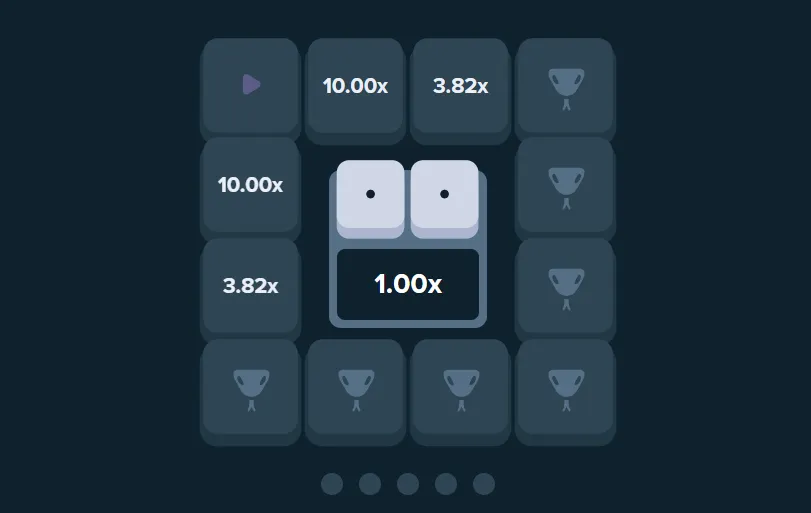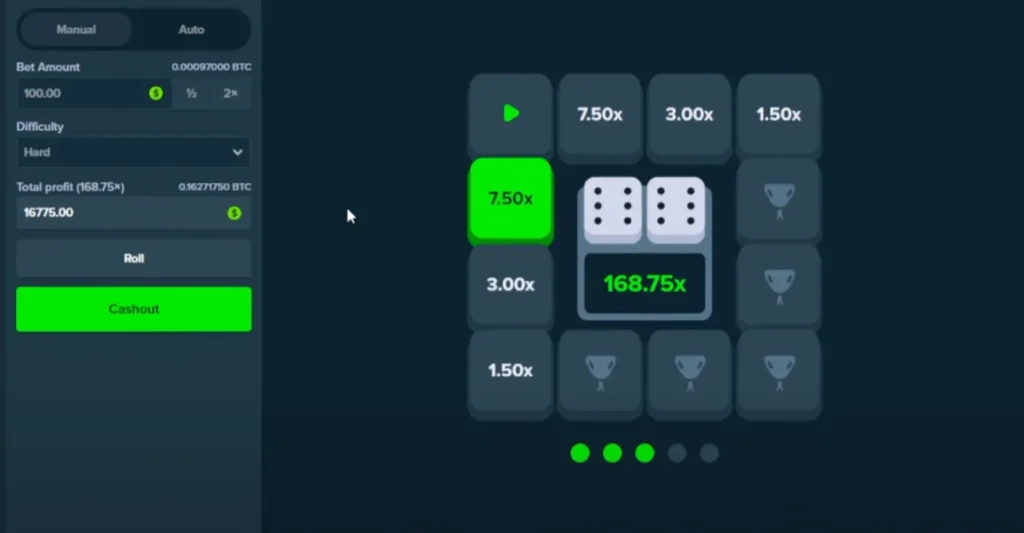Snakes – Stake Originals Game
After spending nearly a week glued to my screen with Stake’s latest original creation, I’m ready to share everything you need to know about the Stake Snakes game. Launched on May 14th, this snake-inspired board game brings a fresh twist to the Stake Originals lineup with its impressive 98% RTP and multiple volatility modes to suit every player’s appetite for risk.

Snakes Game – First Impressions & Theme
When I first loaded Snakes, I was immediately struck by its clean, minimalist design a hallmark of Stake Originals games. The game features a sleek board with numbered squares arranged in a spiral pattern, reminiscent of the classic “Snakes and Ladders” childhood board game, but with a mature, crypto-gambling makeover.
The dark theme with neon green accents creates an atmosphere that’s both engaging and easy on the eyes during longer sessions. Unlike some over-animated casino games, Stake Snakes keeps visual distractions to a minimum while maintaining an engaging interface.
Sound effects are subtle yet satisfying – soft clicks as your token moves across the board, followed by celebratory chimes for wins or an ominous hiss when you hit a snake. You can, of course, toggle these off if you prefer to play in silence.
How Snakes Original Game Works
The Stake Snakes game operates on a surprisingly simple premise:
- Place your bet
- Choose your volatility mode (which determines the number of snakes on the board)
- Click “Roll” to advance your token across the spiral board
- Continue rolling and advancing until you either cash out or land on a snake
Your goal is to navigate the board while avoiding the snakes hidden in certain squares. The further you progress without hitting a snake, the higher your multiplier grows. The game ends immediately when you either manually cash out (taking your accumulated winnings) or land on a snake (losing your bet).
What makes Snakes particularly exciting is the tension between greed and caution. With each successful roll, the multiplier increases, tempting you to push further but so does the risk of hitting a snake and losing everything.

Volatility Modes & Multipliers (Real Session Examples)
Stake Snakes offers five difficulty levels, each with its own risk-reward profile:
| Mode | Snakes | Multiplier Range |
|---|---|---|
| Easy | 1 | 1.08× – 1.96× |
| Medium | 3 | 1.08× – 5.84× |
| Hard | 5 | 1.08× – 24.36× |
| Expert | 7 | 1.08× – 96.42× |
| Master | 10 | 1.08× – 312.56× |
During my ~240 rounds of testing, I primarily stuck to Expert and Hard modes. Expert mode (with 7 snakes) quickly became my favorite for its balance of risk and reward. The potential for 96× multipliers kept things exciting without feeling impossible to achieve.
My most memorable moment came during a Hard mode session where I hit an incredible ×312 multiplier, turning my modest 0.0008 BTC bet into a 0.25 BTC win. Of course, such outcomes are rare during another session in Master mode, I endured the pain of hitting three snakes in consecutive games, resulting in a 0.1 BTC loss.
Betting Tools: Manual, Auto, Instant
Like other Stake Originals, Snakes comes equipped with three distinct betting options:
- Manual Play: The standard mode where you control each roll and decide when to cash out.
- Auto Mode: Set parameters like number of games, target multiplier, and stop-loss limits, then watch the action unfold automatically. I found this particularly useful for testing different strategies across multiple games.
- Instant Mode: Skip the animation and see immediate results perfect for players who prefer rapid gameplay or want to quickly test a strategy.
The betting range accommodates everyone from micro-bettors to high-rollers, with minimum bets as low as 0.0001 BTC and maximums reaching several BTCs depending on your account level.
Big Wins & Lucky Rolls – My Highlights
My Stake Snakes game experience has been a rollercoaster of emotions. Beyond the 312× multiplier mentioned earlier, I’ve had several memorable sessions:
- A nail-biting Expert mode run where I narrowly missed snakes on five consecutive rolls, securing a 56× multiplier
- A satisfying Medium mode streak of eight successful games in a row
- A heartbreaking Master mode attempt where I lost on the final square before hitting what would have been a 200× multiplier
What makes Snakes particularly addictive is how it constantly dangles the possibility of massive wins in front of you. The game shows the multiplier you would have achieved if you’d continued rolling after cashing out a psychological hook that kept me saying “just one more game” far too many times.
Pros and Cons
Pros:
- 98% RTP (2% house edge) makes it one of the fairest games on Stake
- Multiple volatility modes cater to different risk appetites
- Clean, intuitive interface with minimal distractions
- Provably fair algorithm ensures transparency
- Engaging gameplay that’s simple to understand but hard to master
Cons:
- Can be highly addictive due to the “one more roll” temptation
- Limited strategy beyond basic risk management
- No bonus features or special events (yet)
- Winning streaks can create false confidence
- Hard to walk away during a hot streak
Snakes vs. Other Stake Originals (Mines, Crash, Plinko)
How does the Stake Snakes game stack up against other Stake Originals? Here’s my assessment:
Compared to Mines, Snakes offers a more linear progression of risk with clearer multiplier paths, though it lacks the grid-based strategy element that Mines players enjoy.
Unlike Crash, where everyone plays against the same multiplier curve, Snakes provides a more personalized experience. However, it misses the community aspect of watching others cash out (or crash) alongside you.
Plinko fans might appreciate Snakes’ varying volatility options, but Snakes offers more player agency in continuing or cashing out, whereas Plinko is entirely chance-based after the initial drop.
Overall, Snakes carves out its own niche in the Stake Originals lineup by combining the tension of increasing multipliers with the strategic decision of when to cash out.
Final Verdict & Responsible-Play Tips
After a week of intensive play-testing across hundreds of rounds, I can confidently say that Snakes is a worthy addition to the Stake Originals family. Its 98% RTP places it among the most player-friendly games on the platform, while its varying difficulty levels ensure both newcomers and veterans can find their preferred risk level.
The game shines brightest in Expert mode, which offers that sweet spot of substantial potential multipliers without feeling impossibly difficult to win.
However, as with all gambling, responsible play is essential:
- Set strict limits on both time and money before you start playing
- Choose your volatility mode based on your bankroll, not your desire for huge multipliers
- Remember that each roll is independent previous wins don’t increase your chances of future success
- Use Stake’s responsible gaming tools to set deposit limits and reality checks
- Take regular breaks, especially after big wins or losses
Remember that the 2% house edge means that, mathematically, the house will win over time. Approach Snakes as entertainment, not as an income strategy, and you’ll have a much more enjoyable experience.
Frequently Asked Questions about Stake Snakes
Stake Snakes has a 98% RTP, meaning the house edge is only 2%. This makes it one of the fairest games available on the Stake platform.
Choose your volatility mode based on your bankroll and risk tolerance. If you’re new or have a small bankroll, start with Easy or Medium mode. For experienced players seeking bigger multipliers, Expert or Master modes offer higher potential rewards with increased risk.
Yes. Like all Stake Original games, Snakes uses a provably fair algorithm. You can verify each roll through Stake’s provably fair system by checking the client seed, server seed, and nonce for each game round.
The minimum bet is typically around 0.0001 BTC (or equivalent in other cryptocurrencies). Maximum bets vary depending on your VIP level and the cryptocurrency you’re using, but can reach several BTCs for high-level players.
There is no strategy that guarantees wins, as each roll is independent and has the same probability. The best approach is proper bankroll management: set limits, choose volatility levels appropriate for your bankroll, and know when to cash out.
